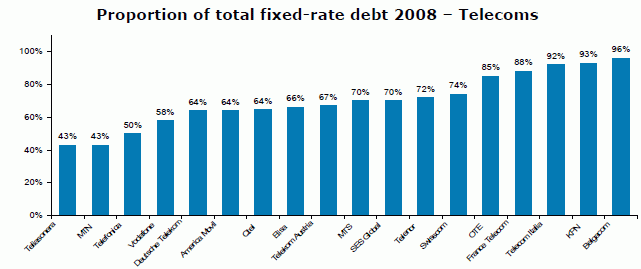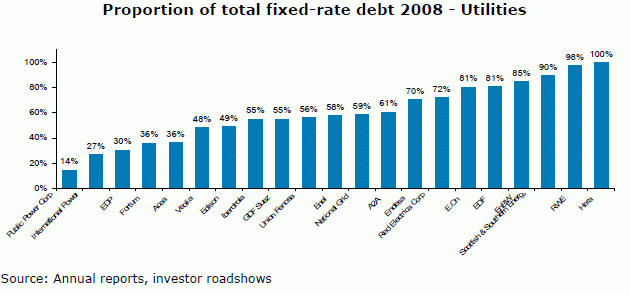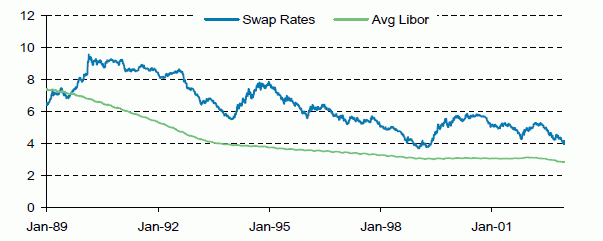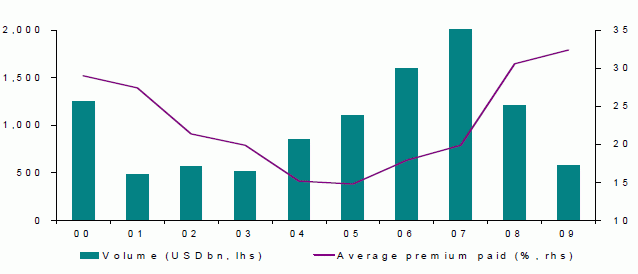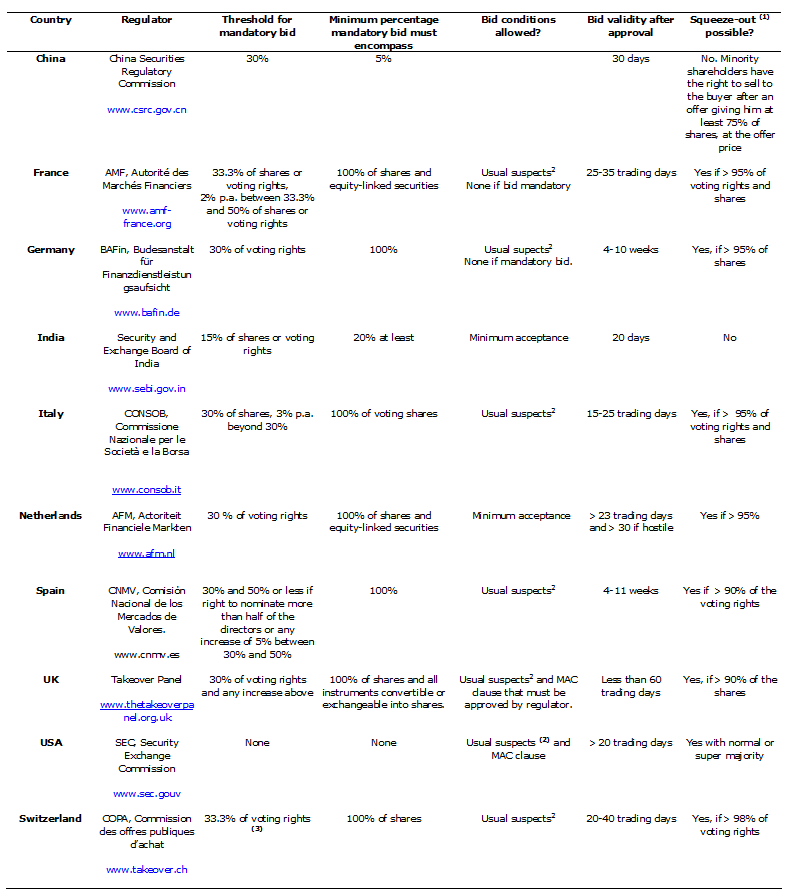Letter number 48 of February 2010
ALL ARTICLES
- TOPIC
- STATISTICS
- RESEARCH
- QUESTIONS & COMMENTS
News : Should one borrow at a fixed or floating rate?
There is a whole world of difference between the management of a firm’s foreign exchange risk and the management of its interest rate risk. The former is generally managed through a tight, formalised and systematic hedging policy aimed at protecting margins and avoiding forex losses and gains. In the field of interest rate management, however, empiricism reigns and the situation at a given moment depends a lot on the accumulation of one-off decisions over time. This deceptively simple topic is, in fact, diabolically complicated. Let's try and clarify our ideas on the subject.
Firstly, it should be remembered that the value of a fixed-rate loan will fluctuate in the opposite direction of the interest rate, which is the logical consequence (1) of the fixed nature of its annual remuneration. On the other hand, the value of a floating-rate loan is generally insensitive to variations in the interest rate since the adjustment to market conditions is made at the level of its coupon which depends on the market rate at the time.
Moreover, thanks to techniques and products available for managing interest rate risk (2), what matters is not so much whether the interest rate set in the loan contracts is fixed or floating, but the position resulting both from the interest rate conditions at the outset and the derivatives that the firm may have purchased to alter its initial position. So, a firm with a fixed-rate debt can shift to a floating-rate exposure thanks to swaps, for example, without having to repay its fixed-rate loan in order take out a loan at a floating rate.
Making guesses about variations in interest rates
Seeking to determine whether it is best to take out debt at a fixed or a floating rate, many borrowers base their decision on their expectations of how interest rates are going to behave. If they think that interest rates are going to rise, they take out loans at a fixed rate and if they think that interest rates are going to fall, they take out loans at a floating rate, so that they will be able to profit from the expected drop in rates. And when interest rates do fall, if their expectations are borne out, then they switch to a fixed rate, hoping to hedge against an inevitable rise in interest rates.
Whether we like it or not, and at the risk of shocking some of our readers, this is what is called speculation (3). The desired result – protection against a hike in interest rates or capitalisation on their fall – is only achieved if expectations are borne out. By default, the firm loses out: the firm that took out fixed-rate debt, believing that the Euribor could not fall to below 2%, suffers an opportunity loss when the Euribor falls to 0.75%. Similarly, the firm that took out floating-rate debt to take advantage of further falls in the interest rate, suffers a loss when interest rates rise.
A market exists because there are players who have different views and/or constraints. Stanley Myint and Adi Shafir have produced the following graphs that clearly show the different attitudes in two industries with massive amounts of debt - the telecoms and utilities sectors:
Policy differences are even very great within the same sector (Telia Sonera vs France Télécom, EdF vs EDP).
Hedging against interest rate fluctuations
Others, more modest about their capacity to guess the future evolution of interest rates, adopt the following rule:
• borrow at a fixed rate in order to be sure how much the resource is going to cost
• invest at a variable rate in order to be sure to avoid capital losses on (temporary) cash surpluses.
Without wanting to and without knowing it, they are also speculating. The combination of these two positions, perceived as risk free, results in a position that is heavily exposed to a rise in interest rates. If interest rates fall, this position exposes the debt holder to opportunity losses on debts (borrowers who borrowed at a fixed rate of 10% would only be paying 6% if they had borrowed at a floating rate) and on investments (investors are only earning 6% on their investments when they would have been earning 10% if they had invested at a fixed rate). If interest rates rise, borrowers who borrowed at a fixed rate are better off than if they had borrowed at a floating rate and investors who invested at a floating rate are better off than those who invested at a fixed rate.
The reader may feel that we are over egging the pudding by comparing accounting losses with opportunity losses. The former are booked on the income statement and they "hurt", while the latter are only noted in the appendix, at the very most, if the debt is valued at market value. But although from an accounting point of view, comparing accounting and opportunity losses is like comparing apples with oranges, from a financial point of view, there can be no doubt, we are talking about the same type of fruit. Just ask the treasurer, who is obsessed with only leaving minimum, incompressible amounts uninvested, even if negligently leaving sums uninvested for a few days has absolutely no negative impact on the income statement.
As we shall see further on, carrying fixed-rate debt makes it possible to identify the accounting cost of the debt over the period, but does not eliminate the risk relating to the value of equity capital. Taking out floating-rate debt results in uncertainty over the cost of the debt on the income statement, but eliminates the risk relating to the value of equity capital.
Let’s content ourselves, at this stage, with observing that accounting plays an important role and can result in the modification of management decisions when it should only, from a logical point of view, reflect economic reality without actually influencing it.
Reasoning in terms of costs
So we can compare the cost of fixed-term debt and floating-term debt in terms of cost. Take the 3-month Euribor rate that today is 0.68%, while the 5-year swap rate (to pay a fixed-rate debt) for the same period is 2.71%. This is because the interest rate curve is currently upward sloping, as is usually the case (4). This comparison is however, insufficient, as it is only made at time t. The floating rate, by definition, will vary over the whole of the loan period. Stanley Myint and Adi Shafir had the excellent idea of comparing the fixed rate at each moment from January 1989 to January 2002 with the average floating rates over 7 years after each moment (which explains why their work ended in 2002).
They show (5) that, over this period, in 96% of cases, floating-rate debt was less expensive than fixed-rate debt. Can we conclude from this that there is a general rule that could be applied in the future? Perhaps, if we consider that the ECB, whose mandate is to guarantee price stability, will not drop its guard and that in the future, inflation will remain low, as it has done since the 1990s.
The fixed rate (swap rate) is in DEM before 1998 and against the Euribor since then.
Additionally, Stanley Myint and Adi Shafir show, over the 1989-2002 period, that there is no correlation between a) the difference at time t between the 7-year fixed rate and the spot floating rate and that b) the difference between the fixed rate obtained at time t and the floating rate obtained over the duration of the period (7 years). In other words, the slope of the interest rate curve at time t, over the last 20 years, has given no indication as to whether it is better to choose fixed-rate or floating-rate debt.
Reasoning in value
But more fundamentally, reasoning in terms of costs doesn’t lead anywhere as it ignores the risk taken. As we point out in the first chapter of the Vernimmen, only a reasoning in terms of value, synthesis between rates of return / interest rates and risk, is of relevance in finance. If we don’t think in these terms, we run the risk of being short-sighted!
Let’s start from the principle that interest rates rise when the economy is in good shape because the monetary authorities are keen to fight against a potential resurgence of inflation or because they withdraw cash from the economic system that they had previously pumped in. Conversely, interest rates fall when the monetary authorities wish to stimulate economic activity when the economy is showing signs of anaemia.
Carrying fixed-rate debt means that, when the economy's performance is mediocre to poor, the debt is revalued because of the drop in the interest rate, while the value of capital employed is quite likely to weaken given the general anaemia, especially for firms operating in cyclical sectors, such as the steel, chemical, transportation and financial sectors. In this case, the value of equity, the difference between the value of capital employed and the value of net banking and financial debt, will suffer a dual impact and accordingly, be highly volatile. If the debt had been at a floating rate, its value would have been constant and accordingly, the impact of variations in the value of capital employed on the value of equity capital would have been lower.
On the other hand, if the economy performs well and interest rates rise, the value of capital employed, especially for cyclical industries, is likely to increase (the effect of improving flows setting off the rise in discount rates), and the value of fixed-rate debt will fall. All in all, the value of equity will increase by more than it would have if the firm had been carrying floating-rate debt.
So, fixed-rate debt, compared with floating-rate debt, will increase the volatility of firms’ equity capital, especially for those operating in cyclical sectors. The latter were able to have their cake and eat it – floating-rate debt reduces the volatility of the value of equity and at the same time costs less, or historically used to cost less that is. On the other hand, non-cyclical sectors (we do not know of any contra-cyclical sectors except for restructuring firms working with bankrupt companies!) have the sometimes difficult choice between appetite for risk (floating-rate debt) and fixed-rate debt which historically has always cost more. This is not unacceptable in itself but it’s not necessarily what one might spontaneously think, as too often, one never poses questions about the economic context in which interest rate hikes may occur. There is a very good chance that they will occur in an economic context in which earnings are rising. Rising earnings will then set off the rising interest rates.
The case of rising interest rates and a simultaneous decline in the economic situation is sufficiently rare (early 1980s to stifle inflation, 1992 at the time of the sterling crisis) and brief for it to be of any real concern.
But if our reader is considering seeking gainful employment in the field, he or she may choose to do what Vodafone does, as explained in their 2008 annual report, and always carry floating-rate debt, except when the risk of interest rate fluctuation is high or when interest rates are low. A leopard cannot change its spots!
Thanks to Franck Bancel, Bruno Labrosse, Jean-Jacques Guiony, François Meunier and of course Stanley Myint whose comments helped us to make this article better.
(1) For more information, see chapter 25 of the Vernimmen.
(2) See chapter 47 of the Vernimmen.
(3) See chapter 15 of the Vernimmen.
(4) For more information, see chapter 24 of the Vernimmen.
(5) To be published in the BNP Paribas Corporate Solutions Handbook 2010.
Statistics : M&A volume and premia in Europe since 2000
Control premia are not constant over time and only the naives believe that it is possible to buy on the cheap the control of a listed group taking advantage of a slump in the stock market mood. The following graph shows that the highest control premia (above 30%) have been registered when the stock market was in the doldrums (2008 and 2009).
Last month, Kraft had to pay a control premia of around 49% to buy Cadbury. The proof is in the chocolate box!
Research : Why are LBOs levered ?
There are two possible ways of arriving at an academic explanation for economic and financial phenomena. The first involves drawing up a theoretical model on the phenomena to be explained, and then carrying out a series of empirical tests to confirm or disprove all of the model’s predictions. The article that we present this month (1) falls into a second category: it suggests a theoretical model that explains facts that have already been empirically established.
The article focuses on the phenomenon of leveraged buyouts (LBOs)(2). It looks specifically at the massive use of debt in these operations (at the origin of the leverage effect) and suggests an explanation linked to the way that private equity funds are financed.
The empirical phenomenon that emerges shows that throughout the world, these funds have identical financing methods. They issue equity securities when they are set up, and then complete their financing needs with debt at the time of the acquisitions (which become LBOs). To explain this, the article shows that there are two possible financing methods - ex ante (when the fund is created) and ex post (deal by deal), and that the optimum is a combination of the two and that debt is necessary for the ex post part of the financing.
Basically, the model goes like this:
ex post financing must be levered (backed by the acquired firm) in order to leave the general partners of the fund with the residual profit from the deal and to encourage them to engage in active management. The problem raised by this type of financing is that the behaviour of funds becomes pro cyclical. When the economy is in good health, there is overinvestment (partners launch too many transactions because part of the risk is transferred to the creditors), and when the economy is in poor health, there is underinvestment (because partners are unable to raise financing, even for profitable deals).
Ex ante financing using equity can partially solve these problems. Partners are encouraged to take good decisions and will not lack equity capital in the event of a downturn in the economy. In order to send out a signal on the quality of their management, since all of the financing is provided at the creation of the fund, the partners must agree to have their remuneration linked to their performance.
The problem turns into an issue of too much freedom granted to partners. If too few profitable transactions arise during the life of the fund, they will invest, after a given period of time, in projects that are too risky, merely in order to attempt to achieve the requested performance.
The optimal means of financing in this model is ultimately a combination of ex ante financing using equity and ex post financing using debt, which ties in with practices observed. Additionally, the other predictions of the model tie in with the empirical studies. Specifically, the fact that LBOs carried out by private equity funds are pro cyclical (3), and the nonlinear nature of partner compensation (4), have been shown to be empirical by Gompers and Lerner.
The quality of this article comes from its ability to explain complex phenomena on the basis of a model that has a simple structure.
(1) U.AXELSON, P.STROMBERG et M.S.WEISBACH (2009), Why are buyouts levered ? The financial structure of private equity funds, Journal of Finance, vol 64, n°4, p.1549-1582.
(2) For more information on LBOs, see chapter 44 of the Vernimmen.
(3) P.GOMPERS et J.LERNER (1999), The Venture Capital Cycle , MIT Press, Cambridge.
(4) P.GOMPERS et J.LERNER (1999), An analysis of compensation in the U.S. venture capital partnership, Journal of Financial Economics, n°51, pages 3 à 44.
Q&A : Comparison of takover rules in some countries
(1) That is possibility for the majority shareholder to force the buy-back of minority shareholders and delist the company if minority shareholders represent only a small part of the capital.
(2) Minimum acceptance, antitrust authorisations, authorisation of shareholders to issue shares.
(3) Or a threshold up to 49% if the by-laws of the target company permit.
